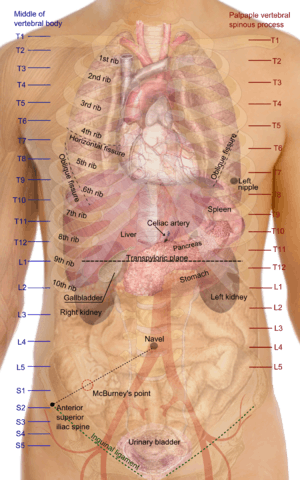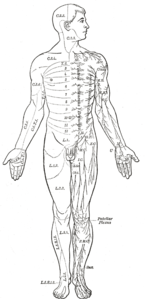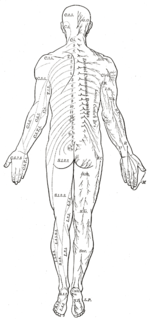Torso
| Torso | |
|---|---|
 Human male torso | |
| Details | |
| Identifiers | |
| Latin | truncus |
| TA | A01.1.00.013 |
| FMA | 7181 |
The torso or trunk is an anatomical term for the central part of the many animal bodies (including that of the human) from which extend the neck and limbs.[1] The torso includes the thorax and the abdomen.
Anatomy
Major organs

Most critical organs are housed within the torso. In the upper chest, the heart and lungs are protected by the rib cage, and the abdomen contains most of the organs responsible for digestion: the stomach, which breaks down partially digested food via gastric acid; the liver, which respectively produces bile necessary for digestion; the large and small intestines, which extract nutrients from food; the anus, from which fecal wastes are excreted; the rectum, which stores feces; the gallbladder, which stores and concentrates bile; the kidneys, which produce urine, the ureters, which pass it to the bladder for storage; and the urethra, which excretes urine and passes sperm through the seminal vesicles. Finally, the pelvic region houses both the male and female reproductive organs.
Major muscle groups
The torso also harbours many of the main groups of muscles in the body, including the:
Innervation
The organs and muscles etc. are innervated by various nerves, mainly originating from thoracic vertebrae segments. For instance, the cutaneous innervation is provided by:
- Ventral cutaneous branches
- Lateral cutaneous branches of torso|Lateral cutaneous branches
- Dorsal cutaneous branches
 Distribution of cutaneous nerves. Ventral aspect. Dorsal and lateral cutaneous branches labeled at center right.
Distribution of cutaneous nerves. Ventral aspect. Dorsal and lateral cutaneous branches labeled at center right. Dorsal aspect. Ventral and lateral cutaneous branches labeled at center right.
Dorsal aspect. Ventral and lateral cutaneous branches labeled at center right.
See also
| Wikimedia Commons has media related to Torsos. |
References
| Look up trunk in Wiktionary, the free dictionary. |